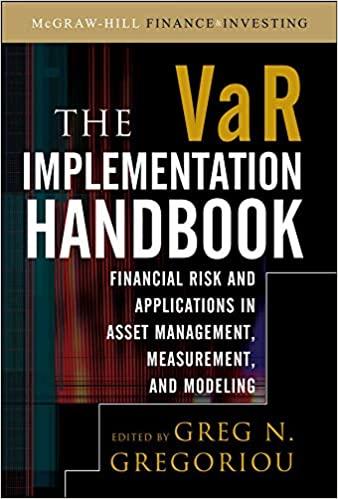Can someone please walk me through this? It is going over my head. I just need it broken down into steps. Thanks!



Solutions to Dxl Corporation 1. Relax Credit Standards 1 -incremental invest in A/R-ga A/R) - V[ACPN(AS/360)] 0.745(1,000,000/360)]-.745(2777.78)]-87,500 -incremental profits [ASH - V)] - BN(AS) - 1,000,000(.3) - .05(1,000,000)-250,000 NPVCA = P-k(AI) _ 250,000-.15(87,500) = 236,875 .. THE CHANGE IS PROFITABLE 2. Lengthen The Credit Period to 45 Days 1 -increased investment in A/R from original sales + investment in A/R from new sales = (ACPy-ACPO(So/360) + V[ACPN(AS/360)] When we lengthen the credit period, why don't we multiply by V, i.e., use VACPN- ACPo) (So/360)? The answer requires us to consider opportunity costs 1. We were selling $41,667 per day. A/R totaled (3041,667) = $1,250,000, of which .7(1,250,000) = $875,000 represents an investment which we had to finance Thirty days ago, we sold goods for $41,667, which required an investment of S29,167 Tomorrow, if we don't change our credit policy, we will collect $41,667, which represents (1) a recovery of the S29,167 of variable costs plus (2) a gross profit of .3(41,667)- $12,500. We presumably use the $29,167 to cover the material we will sell tomorrow, while we can use the S12,500 cash for anything we choose - paying dividends, reducing bank loans, etc. We have the opportunity to use it and earn a return on it. 2. 3. If we o change our credit policy, we will go through a 15 day transition period during which we will not collect (4.663 05) = $625,000 that we otherwise would have collected. The $625,000 can be split into two components, (20M wu5)-$437,500, which represents an additional investment which we must finance, and the remaining (12,500) (15) - S187,500, which represents the cumulative gross profits which we would have collected if we had not changed our credit policy. We incur financing costs on the S437,500 and opportunity costs on the $187,500, so there are some costs on the whole $625,000 In summary, the incremental effect of the credit policy change on our old sales is: Increased investment-WACPN-ACPo)(So/360) Opportunity loss1-ACP - ACPo)(So/360) TOTAL 4. = 437,500 = 187,500 = (V + 1-WACPy_ ACPo)(So/360) = 625,000 If we add the increased investment and the opportunity loss we get (ACPN - ACPeSo/360) because V (1-V)1 Solutions to Dxl Corporation 1. Relax Credit Standards 1 -incremental invest in A/R-ga A/R) - V[ACPN(AS/360)] 0.745(1,000,000/360)]-.745(2777.78)]-87,500 -incremental profits [ASH - V)] - BN(AS) - 1,000,000(.3) - .05(1,000,000)-250,000 NPVCA = P-k(AI) _ 250,000-.15(87,500) = 236,875 .. THE CHANGE IS PROFITABLE 2. Lengthen The Credit Period to 45 Days 1 -increased investment in A/R from original sales + investment in A/R from new sales = (ACPy-ACPO(So/360) + V[ACPN(AS/360)] When we lengthen the credit period, why don't we multiply by V, i.e., use VACPN- ACPo) (So/360)? The answer requires us to consider opportunity costs 1. We were selling $41,667 per day. A/R totaled (3041,667) = $1,250,000, of which .7(1,250,000) = $875,000 represents an investment which we had to finance Thirty days ago, we sold goods for $41,667, which required an investment of S29,167 Tomorrow, if we don't change our credit policy, we will collect $41,667, which represents (1) a recovery of the S29,167 of variable costs plus (2) a gross profit of .3(41,667)- $12,500. We presumably use the $29,167 to cover the material we will sell tomorrow, while we can use the S12,500 cash for anything we choose - paying dividends, reducing bank loans, etc. We have the opportunity to use it and earn a return on it. 2. 3. If we o change our credit policy, we will go through a 15 day transition period during which we will not collect (4.663 05) = $625,000 that we otherwise would have collected. The $625,000 can be split into two components, (20M wu5)-$437,500, which represents an additional investment which we must finance, and the remaining (12,500) (15) - S187,500, which represents the cumulative gross profits which we would have collected if we had not changed our credit policy. We incur financing costs on the S437,500 and opportunity costs on the $187,500, so there are some costs on the whole $625,000 In summary, the incremental effect of the credit policy change on our old sales is: Increased investment-WACPN-ACPo)(So/360) Opportunity loss1-ACP - ACPo)(So/360) TOTAL 4. = 437,500 = 187,500 = (V + 1-WACPy_ ACPo)(So/360) = 625,000 If we add the increased investment and the opportunity loss we get (ACPN - ACPeSo/360) because V (1-V)1









